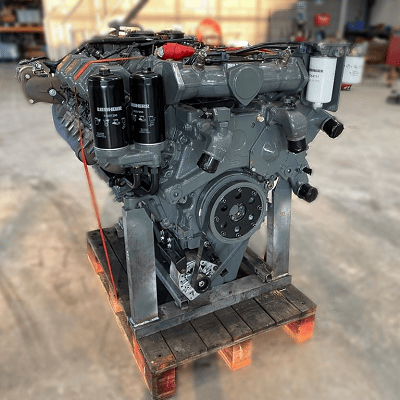The process of a dyno test on a Liebherr engine

When it comes to heavy machinery, reliability and power are paramount. Liebherr, a name synonymous with innovation and excellence in engineering, stands tall as a pioneer in the realm of heavy equipment and machinery. From towering cranes to robust excavators, Liebherr’s engineering prowess extends to the heart of these machines. We delve into the world of dyno testing a Liebherr engine, uncovering the meticulous process behind unleashing the raw power concealed within.
The foundation of excellence
Before we embark on the journey of dyno testing, it’s crucial to understand the foundation upon which Liebherr engines are built. With decades of engineering expertise and commitment to quality, Liebherr engines are crafted to withstand the most demanding environment and deliver unparalleled performance. Each component is meticulously designed and rigorously tested to ensure reliability, efficiency and longevity.
The process
1 Preparation: The engine undergoes meticulous preparation before being mounted onto the dynamo meter. This includes ensuring all connections are secure, fluids are filled to the appropriate levels, and sensors are properly calibrated.
2 Mounting: The engine is carefully mounted onto the dynamometer, a specialized device designed to simulate real-world operating conditions. Precision is paramount during this step to ensure accurate results.
3 Initial checks: Once mounted, a series of initial checks are conducted to verify proper alignment, connection integrity, and functionality of all engine systems.
4 Warm-up: The engine is started and allowed to warm up to operating temperature. This ensures consistent results and minimizes the risk of damage during testing.
5 Baseline testing: With the engine warmed up , baseline tests are conducted to establish initial performance metrics. This includes measuring power output, torque, fuel consumption, and emissions at various RPM levels.
6 Load testing: The engine is subjected to progressively increasing loads to simulate different operating conditions, such as idle, partial load and full load. This allows engineers to assess performance across the entire operating range and identify any potential issues or optimization.
7 Data analysis: Throughout the testing process, data is continuously collected and analyzed in real-time. Advanced instrumentation and software are used to monitor performance metrics and identify trends or anomalies.
8 Optimazation: Based on the data analysis, adjustments may be made to optimize engine performance. This could involve fine-tuning fuel injection timing, adjusting air-fuel ratios, or optimize turbocharger boost pressure.
9 Validation: Once testing is complete, the results are meticulously reviewed and validated against predetermined criteria and specifications. Any deviations or anomalies are thoroughly investigated to ensure accuracy and reliability.
10 Reporting: Finally, a comprehensive report is generated detailing the results of the dyno testing, including performance metrics, observations, and any recommendations for further optimization or refinement.
The outcome of dyno testing
Dyno testing a Liebherr engine is more than just a routine procedure – it’s a testament to the unwavering commitment to excellence that defines Liebherr’s engineering philosophy. By subjecting their engines to rigorous testing and analysis, Liebherr ensures that each engine delivers the uncompromising performance, reliability, and efficiency that customers expect.
In conclusion, dyno testing a Liebherr engine is not just about measuring power output. It’s about unlocking the true potential of these remarkable engines and ensuring they exceed expectations in the most challenging environments imaginable.
Electric Cylinder With Ball Screw
Electric Cylinder Features
*Internally equipped with a pair of high-strength tapered roller bearings that meet both thrust and tension conditions;
*Good lubrication characteristics, operating environment temperature.
*High quality hydraulic oil seals are used at both ends of the cylinder block, with excellent sealing performance;
*Equipped with two travel limit sensors.
The relationship between the output torque of the motor and the output force of the electric cylinder

Model number indication

Optional Installation Accessories

Selection of anti rotation and non anti rotation for electric cylinder telescopic rod
Due to the high transmission efficiency and lack of self-locking characteristics of the ball screw inside the electric cylinder, when the expansion rod nut moves in a straight line inside the electric cylinder barrel, the expansion rod nut will rotate slightly in the direction of the ball screw thread due to inertia and friction. When the internal anti rotation limit of the electric cylinder or the end of the telescopic rod is connected to a non rotating structural component using a U-shaped double ear seat (or thread), the rotational movement of the telescopic rod is restricted, and the electric cylinder telescopic rod can be retracted without rotation. The general application requires anti-rotation restrictions on the piston rod. In some cases, such as front and rear U-shaped fork foot electric cylinders, six degree of freedom platforms, etc., electric cylinders without anti rotation structures are required. The rotation of the telescopic rod will affect the displacement accuracy of the electric cylinder, and it should generally be determined in the early stage of selection whether the electric cylinder requires anti rotation.
Electric Cylinder For Medical Equipment,Electric Cylinder For Industrial Machinery,Electric Linear Actuation Solution,Electric Linear Automation For Applications,Servo Electric Cylinder
Shenzhen Packway Technology Development Co., LTD , https://www.packwaymachines.com